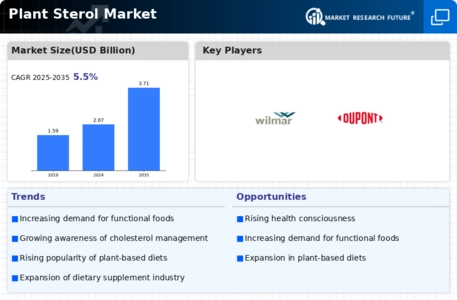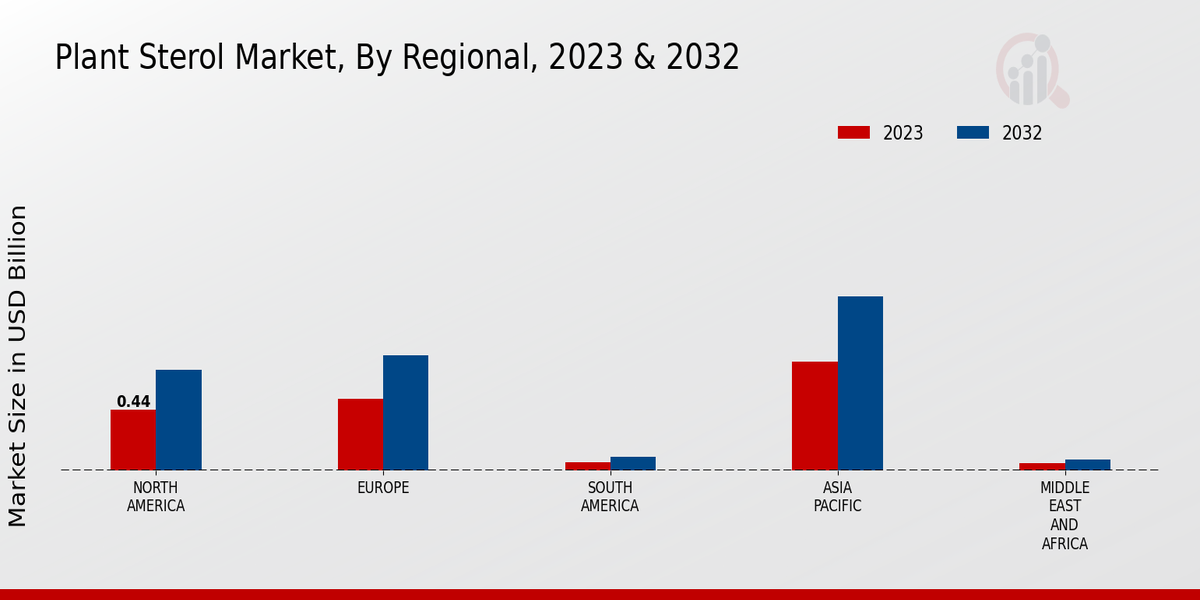Rising Health Awareness
The increasing global awareness regarding health and wellness is a primary driver for the Global Plant Sterol Market Industry. Consumers are becoming more conscious of their dietary choices, leading to a surge in demand for functional foods that promote heart health. Plant sterols, known for their cholesterol-lowering properties, are gaining traction among health-conscious individuals. In 2024, the market is projected to reach 2.07 USD Billion, reflecting the growing inclination towards preventive healthcare. This trend is expected to continue as more individuals seek natural alternatives to manage cholesterol levels, thereby enhancing the market's growth trajectory.
Market Growth Projections
The Global Plant Sterol Market Industry is poised for substantial growth, with projections indicating a rise from 2.07 USD Billion in 2024 to 3.71 USD Billion by 2035. This growth trajectory suggests a compound annual growth rate of 5.46% from 2025 to 2035, reflecting increasing consumer awareness and demand for health-promoting products. The market's expansion is likely to be driven by various factors, including regulatory support, innovations in product development, and the growing prevalence of health-conscious lifestyles. As the industry evolves, it may present new opportunities for stakeholders and contribute to the overall health and wellness sector.
Innovations in Product Development
Innovations in product development are driving growth within the Global Plant Sterol Market Industry. Manufacturers are increasingly exploring new formulations and applications for plant sterols, leading to the creation of diverse products that cater to various consumer preferences. For instance, the introduction of plant sterol-infused beverages and snacks is expanding the market's reach. This innovation not only attracts health-conscious consumers but also encourages broader acceptance of plant sterols in everyday diets. As a result, the market is expected to see a steady increase, with projections indicating a rise to 3.71 USD Billion by 2035.
Growing Demand for Functional Foods
The demand for functional foods is on the rise, significantly impacting the Global Plant Sterol Market Industry. Consumers are increasingly seeking foods that offer health benefits beyond basic nutrition, and plant sterols fit this criterion perfectly. As more individuals look for ways to improve their overall health, the incorporation of plant sterols into everyday foods, such as margarine and yogurt, is becoming more prevalent. This trend is expected to drive the market's growth, with a projected compound annual growth rate of 5.46% from 2025 to 2035. The increasing availability of fortified products is likely to further enhance consumer adoption.
Regulatory Support for Plant Sterols
Government regulations and endorsements play a crucial role in shaping the Global Plant Sterol Market Industry. Regulatory bodies, such as the FDA and EFSA, have recognized the health benefits of plant sterols, allowing for health claims on food products containing these compounds. This regulatory support encourages manufacturers to incorporate plant sterols into their products, thereby expanding their market reach. As a result, the market is anticipated to grow significantly, with projections indicating a rise to 3.71 USD Billion by 2035. Such favorable regulations not only enhance consumer trust but also stimulate innovation in product formulations.
Aging Population and Cardiovascular Health
The aging global population is a significant driver for the Global Plant Sterol Market Industry, particularly concerning cardiovascular health. As individuals age, the risk of heart disease increases, prompting a greater focus on preventive measures. Plant sterols have been shown to effectively lower LDL cholesterol levels, making them an attractive option for older adults seeking to maintain heart health. This demographic shift is expected to contribute to the market's expansion, with the industry projected to reach 2.07 USD Billion in 2024. The growing emphasis on heart health among the elderly population is likely to sustain demand for plant sterol-enriched products.




